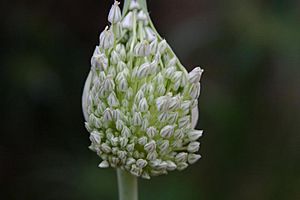Elephant garlic facts for kids
Quick facts for kids Elephant garlic |
|
|---|---|
 |
|
| Scientific classification |
|
| Kingdom: | Plantae |
| Clade: | Tracheophytes |
| Clade: | Angiosperms |
| Clade: | Monocots |
| Order: | Asparagales |
| Family: | Amaryllidaceae |
| Subfamily: | Allioideae |
| Genus: | Allium |
| Species: | |
| Varietas: |
A. a. var. ampeloprasum
|
| Trinomial name | |
| Allium ampeloprasum var. ampeloprasum |
|
Elephant garlic is a fascinating plant that looks a lot like a giant garlic bulb! It's actually a type of onion, not a true garlic, but it belongs to the same plant family. This plant grows a tall, strong stem with wide, flat leaves.
The taste of elephant garlic is much milder than regular garlic. You can enjoy it raw in salads, roasted until it's soft, or lightly cooked. While it's delicious, it usually isn't used as a direct replacement for regular garlic in recipes because of its gentle flavor. Sometimes, people confuse it with solo garlic, which is a single, round clove of garlic.
Contents
Growing Elephant Garlic
Planting and Harvesting
Elephant garlic grows from large cloves that have papery skins, just like regular garlic. These big cloves are used for both cooking and planting new plants. You might also find smaller, hard-shelled pieces called corms growing on the outside of the main bulb.
Many gardeners don't pay much attention to these small corms. However, if you plant them, they will grow into a single, solid bulb in the first year, without producing a flower. In the second year, this single bulb will then split into many separate cloves, just like a normal elephant garlic bulb. Even though it takes an extra year, planting these small corms is a great way to get more plants and increase your harvest!
Leaving Plants in the Ground
Unlike many types of garlic, you don't always have to dig up elephant garlic every year. You can often leave it in the ground without worrying too much about it rotting. If left alone, the plant will spread out into a bigger clump. Each clove will grow its own stalk and flower.
These plants are often kept in flower gardens because they look pretty and can help keep pests away. However, if they get too crowded, the plants might not grow as well, and some parts could start to rot. Elephant garlic is usually not grown from seeds.
Cooking with Elephant Garlic
Just like regular garlic, elephant garlic can be roasted whole. You can bake it in the oven or grill it. Once it's soft, you can mash it and spread it on toast with butter.
When elephant garlic is fresh, it contains a lot of water. If you cook it right away, it might foam up like boiling potatoes. If you store it in a cool, dry place like a basement for a few months, it loses some moisture. This drying process helps to bring out a richer, fuller flavor.
What Makes Elephant Garlic Special?
Elephant garlic has a unique mix of flavors. Scientists have studied it and found that it contains special compounds. It has allicin, which is the compound that gives regular garlic its strong smell and taste. But it also has syn-propanethial-S-oxide, which is the compound that makes you cry when you cut an onion or leek. This mix of compounds shows that elephant garlic is more closely related to leeks than to true garlic.
When to Plant Elephant Garlic
You can plant elephant garlic at two different times of the year. You can plant it in the spring or in the autumn. In places with warmer weather, you can even plant it in the winter. This allows you to harvest it in the late spring.
Images for kids


